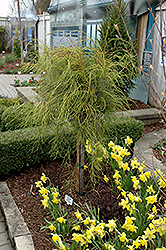Fri & Sat 8am - 8pm
Sun 8am - 7pm
Anytown, USA 12345
fax: 261.787.0463
e-mail: info@successgc.com


Plant Finder

Height: 8 feet
Spread: 4 feet
Sunlight:
![]()
![]()
Hardiness Zone: 3b
Other Names: Eastern White Cedar
Description:
A very interesting evergreen which features arching sprays of fine, thread-like bright green foliage on a weeping tree form; unquestionably distinctive, use as a solitary accent in the garden; needs shelter from drying winds
Ornamental Features
Threadleaf Arborvitae is primarily valued in the landscape or garden for its highly ornamental weeping form. It has attractive green evergreen foliage which emerges light green in spring. The threadlike sprays of foliage are highly ornamental and remain green throughout the winter.
Landscape Attributes
Threadleaf Arborvitae is an evergreen dwarf tree with a strong central leader and a rounded form and gracefully weeping branches. It lends an extremely fine and delicate texture to the landscape composition which can make it a great accent feature on this basis alone.
This is a relatively low maintenance dwarf tree. When pruning is necessary, it is recommended to only trim back the new growth of the current season, other than to remove any dieback. It has no significant negative characteristics.
Threadleaf Arborvitae is ideal for use as a garden accent or patio feature, and is recommended for the following landscape applications;
- Accent
- General Garden Use
Planting & Growing
Threadleaf Arborvitae will grow to be about 8 feet tall at maturity, with a spread of 4 feet. It tends to be a little leggy, with a typical clearance of 4 feet from the ground, and is suitable for planting under power lines. It grows at a slow rate, and under ideal conditions can be expected to live for 50 years or more.
This dwarf tree does best in full sun to partial shade. It prefers to grow in average to moist conditions, and shouldn't be allowed to dry out. It is not particular as to soil type or pH. It is somewhat tolerant of urban pollution, and will benefit from being planted in a relatively sheltered location. Consider applying a thick mulch around the root zone in winter to protect it in exposed locations or colder microclimates. This is a selection of a native North American species.
